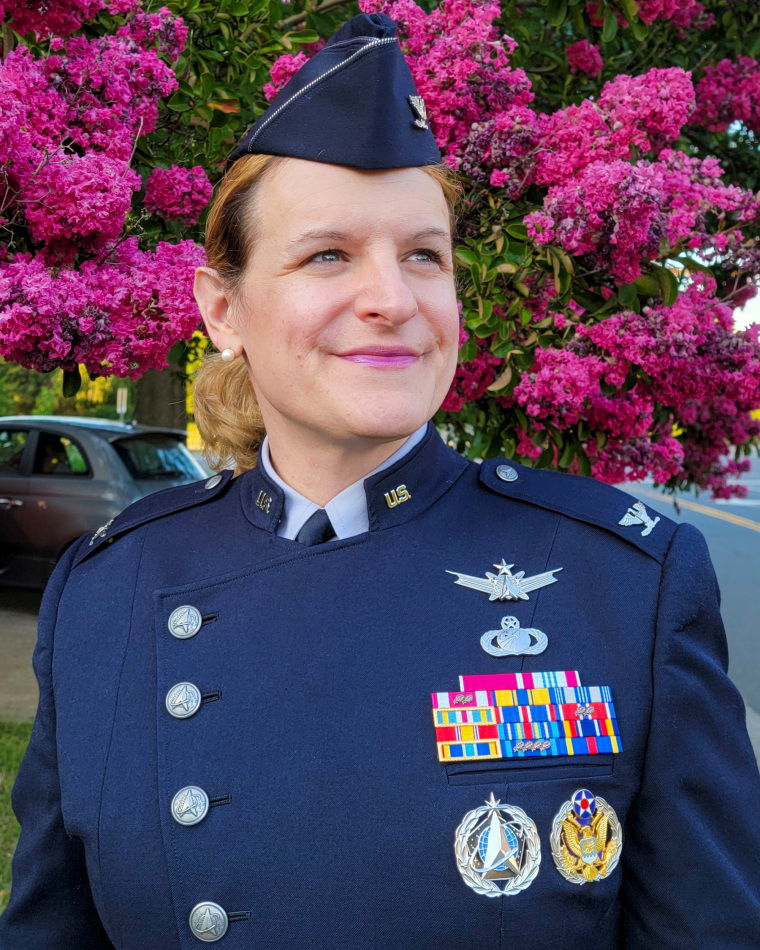
Earlier this month, the Defense Department told transgender service members that they had to choose whether they would voluntarily or involuntarily separate from the military.
Four trans service members who are now in the process of separating said nothing about their decisions feels voluntary at all.
“Nobody feels like this is voluntary,” said Emily Shilling, a commander in the Navy and the president of SPARTA, a nonprofit group that advocates for trans service members. “This is coercion. This is under duress.”
President Donald Trump signed an executive order a week into his administration prohibiting trans people from enlisting or serving in the military. Trans service members sued, and a federal judge temporarily blocked the order from taking effect. Then, last month, the Supreme Court allowed the Trump administration to enforce the order. Days later, the Defense Department issued guidance requiring active duty service members to voluntarily self-identify as having been diagnosed with gender dysphoria, which is the distress that results from a misalignment between one’s birth sex and gender identity, by June 6 and reserve service members to self-identify by July 7.
After that, the guidance said, the military will find trans service members who didn’t self-identify through medical readiness programs and begin involuntarily separating them. Affected service members “are eligible for an array of benefits,” the guidance said, including separation pay, “which will be higher for those who self-identify and agree to a voluntary separation.”
However, many details are still unknown, such as what benefits trans service members will be able to access and whether they will all receive honorable discharges. It’s also unclear how many service members will be affected. Just over 4,000 transgender people currently serve in the military, according to Defense Department data, and the department said last month that about 1,000 trans service members have begun the separation process from the military after voluntarily identifying themselves. The department said Tuesday that it does not have an updated number of affected service members.
“Characterization of service will be honorable except where the Service member’s record otherwise warrants a lower characterization,” a U.S. Defense official said in a statement to NBC News. “Military Services will follow normal processes for administrative separation.”
The four trans service members who spoke to NBC News all emphasized that they are speaking in their personal capacity and not on behalf of their respective branches. The biggest question they all face is what comes next.
Bree Fram
On June 30, 2016, the day then-Defense Secretary Ash Carter announced that transgender people could serve openly in the military, Bree Fram, who was then a lieutenant colonel in the Air Force, came out to her teammates in an email as a trans woman and then went to burn off her nerves at the gym.

When she returned to her desk later, she said her colleagues approached her one by one, shook her hand, and told her a version of “It’s an honor to serve with you.”
Fram, who is 46 and now a colonel for the U.S. Space Force at the Pentagon, said that scene repeated earlier this month with leaders from other branches of the military when she told them it would be her last meeting with them. An officer sitting next to her asked where she was going, and she said, “I’m being placed on administrative leave because I don’t meet this administration’s standards for military excellence and readiness.”
Fram said there was a moment of silence before it seemed like her colleagues realized which policy she was referring to — because, she said, trans service members don’t “walk into a room and lead with our identity.”
“I walk into a room and someone sees a colonel, and they see the uniform, and they see all the things that represents about my experience and my expertise,” said Fram, who is one of the highest-ranking out trans officials in the military.

Then, Fram said her colleagues walked over, one by one, and shook her hand and said, again, that it had been an honor to serve with her.
Fram, who served for 22 years until she was placed on administrative leave on June 6, was the director of requirements integration for the Space Force. She helped to identify future technological capabilities the military will need and provided those to developers who built them. She said she planned to serve “for many years to come,” because she loved her job and the team that she worked with.
Fram said she doesn’t know what she’ll do next, but she expects she’ll work in public service.
“I believe in this country, even though it may not believe in me right now,” Fram said. “The oath I swore and the ideals that are embedded in the Constitution still matter to me, and I believe they are worth fighting for.”
Sam Rodriguez
Sam Rodriguez, 38, was recently commissioned as a Medical Service Corps officer in the Navy and was supposed to begin officer training school and then a two-year clinical fellowship in San Diego to become a licensed clinical social worker. However, about a week after the Supreme Court decision allowing the trans military ban to take effect, Rodriguez, who uses they/them pronouns, said the Navy canceled those orders.

“It was really gut-wrenching to receive that news,” Rodriguez said. They enlisted in 2015 and planned to serve for 15 or 20 years, when they would’ve left the Navy as an experienced licensed social worker. However, now they will leave with their master’s degree in social work, and they will have to look for an employer who is willing to provide supervision for them to receive their clinical license, which will be more difficult.
They submitted their resignation earlier this month and requested a separation date in the fall. They said they don’t think they’ll be able to find an entry-level job as a civilian that’s going to match their current salary, housing allowance, health care benefits and the stipend that they and their wife get to pay for child care for their two children.
They plan to move their family from San Diego to Washington, D.C., so they can become more involved in policy advocacy. Outside of work, they are a board member and membership director for SPARTA.
“People need to realize that this is a national security issue,” Rodriguez said, pointing to research from the Modern Military Association of America, an advocacy group for LGBTQ military members and veterans, which found that 73% of trans service members have between 12 and 21 years of experience.
“We’re not going to be one-for-one swapped tomorrow, and some people it will take two decades to replace,” they said.
Emily Shilling
Shilling, 42, is the highest-ranking out trans person in the Navy after having served for nearly two decades, including in over 60 combat missions in Iraq and Afghanistan. She was also one of the lead plaintiffs in a lawsuit against the administration’s ban.
After Trump was elected, she requested to retire in the fall. Her intention was to rescind that retirement because she expected that the ban on trans troops serving would be blocked, but with the policy taking effect, her last day was June 12, and she will officially retire in September.

“I am deeply heartbroken that this is how my career has ended, but also deeply proud of what I’ve done,” Shilling said. “I lived my dream. I did everything I ever wanted to in the Navy and I did it honorably, and I stood proud. I might be getting out of the Navy, but it’s not me quitting this fight. I’m just choosing to take on this fight in a different way.”
Shilling said the Navy invested $40 million in training her, and as a result she has many desirable skills and has already accepted an offer to work in defense technologies and advanced development. However, she said her story is rare among trans service members, thousands of whom will be looking for private sector jobs for the first time.
Shilling said the lawsuit against the ban will return to the 9th Circuit Court of Appeals for a hearing in October, but by that time, most trans service members will be out of the military.
“The irreparable harm is done now,” she said.
Alex Shaffer
Alex Shaffer, 48, joined the military as a combat medic in the Oregon Army National Guard in 2007. His mentors in the guard convinced him to go to school to become a physician’s assistant, and he now also works in a private family practice as a PA.

“In all of the military, it’s a family,” Shaffer said of what he’s enjoyed about serving in the guard.

Shaffer said he planned to stay in the guard “until I could no longer physically serve or they kicked me out for being too old.” He was in the process of trying to commission as an officer. However, his last drill was June 7, because he began the process to medically separate from the National Guard as a result of the ban. (The National Guard only provides retirement benefits to service members if a medical evaluation board deems them physically unfit for duty.)
“I’m devastated,” Shaffer said. “It’s a loss of identity to me. I’ve been a soldier for so long, and it’s a part of who I am.”

Leave a Reply